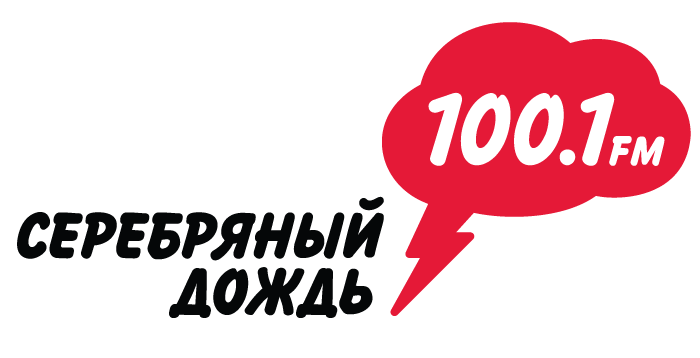Thousands of Suns
The nuclear tests of 1945-1962. On the materials of American archives
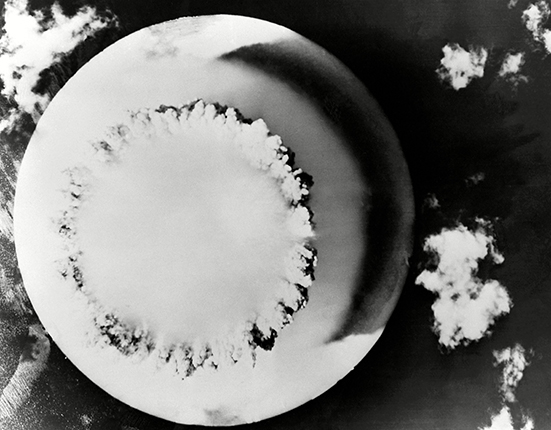
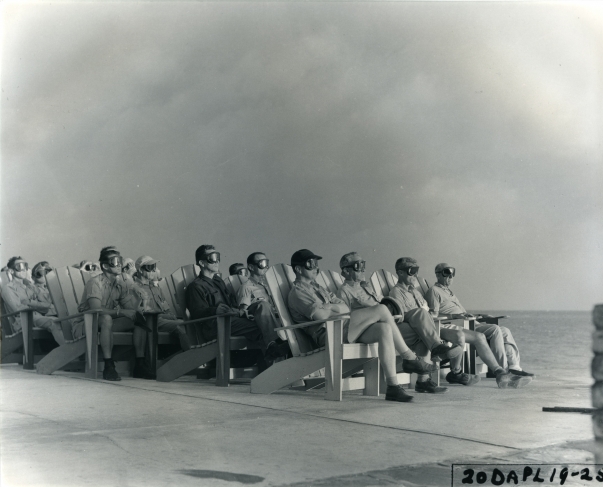
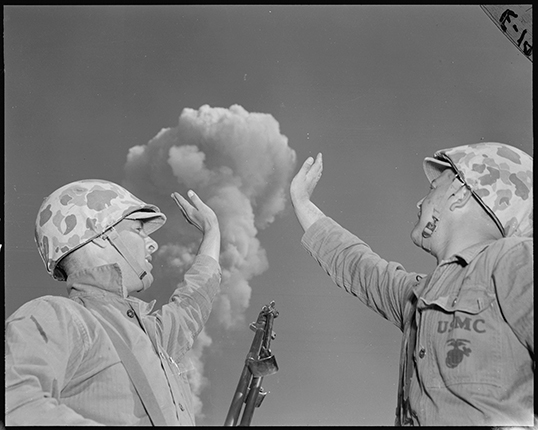
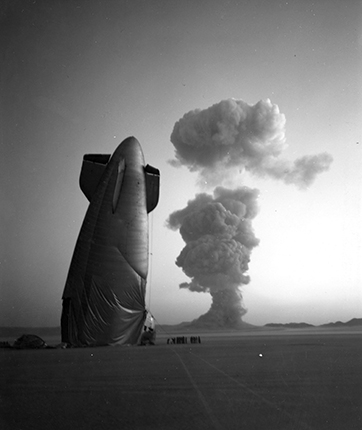
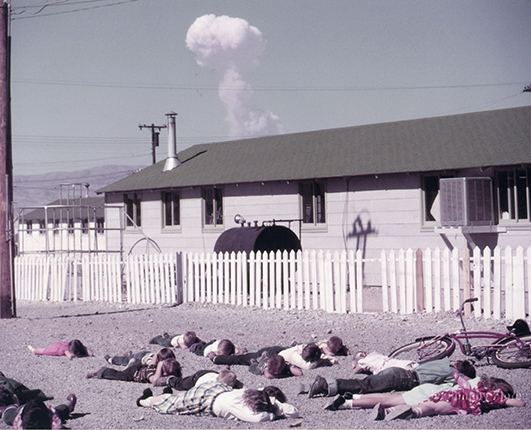
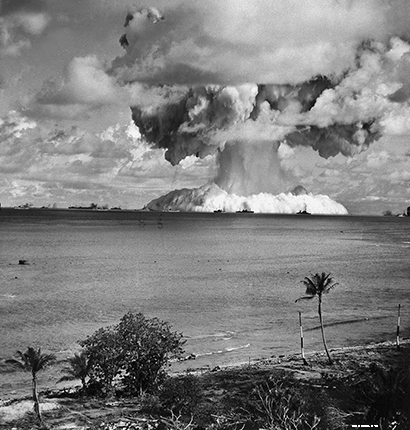
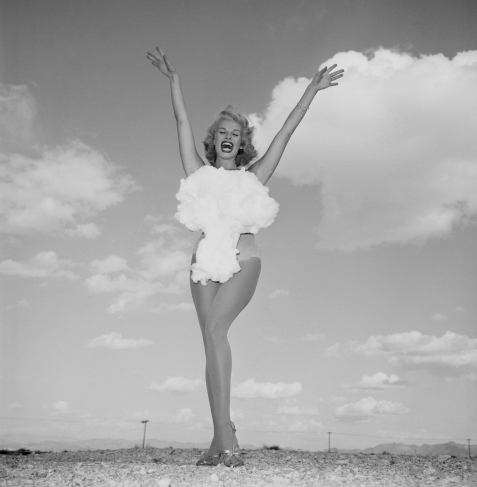
Operation name: Crossroads. Test name: Baker. Date and time: July 25, 1946, 08:35. Test location: Bikini Atoll, Pacific Ocean. Explosion type: underwater bomb. Explosive placement depth: 27.5 m. Yield: 21 kilotons. Photograph taken from aboard an unmanned aircraft flying over the epicentre of the explosion.
Operation name: Greenhouse. Test name: Dog. Date and time: April 8, 1951, 06:33. Location: Eniwetok Atoll, Pacific Ocean. Yield: 81 kilotons. VIP audience, illuminated by the explosion flash, watch the nuclear test. Photo: unknown author. Source: National Archives and Records Administration, Washington, USA
Operation name: Tumbler-Snapper. Date and time: May 1, 1952, 08:30. Test location: Range in Nevada. Explosion type, explosive placement: aerial, airdrop. Explosion height: 316 m. Yield: 19 kilotons. Marine infantry Pot and Wilson, ‘supporting’ the atomic mushroom during the Desert Rock IV exercise. Photo: unknown author. Source: National Archives and Records. Administration, Washington
Operation name: Plumbbob. Date and time: August 7, 1957, 04:25. Test location: Range in Nevada. Explosion type, explosive placement: aerial, balloon. Explosion height: 450 m. Yield: 19 kilotons. The ZSG-3 airship, downed by the shock wave from the explosion. Photograph taken from a distance of 8km from the test site. Photo: unknown author. Source: National Archives and Records. Administration, Washington
Operation name: Tumbler-Snapper. Test name: Charlie. Date and time: April 22, 1952, 09:30. Test location: Range in Nevada. Explosion type, explosive placement: aerial, airdrop. Explosion height: 1050 m. Yield: 31 kilotons. Rural schoolchildren practicing the duck and cover protection method with a real atomic bomb explosion in the background. (Duck and Cover was American educational and propaganda film about civil defence, filmed in 1952 by the US Government). The photo was taken in Indian Springs, Nevada, located 40 km from the epicentre. Photo: John Flory. Source: Frank Zodl/ThePhotoArchive.
Operation name: Crossroads. Date and time: July 25, 1946, 08:35. Test location: Bikini Atoll, Pacific Ocean. Explosion type: underwater bomb. Yield: 21 kilotons. As a result of the blast about two million tons of seawater was raised into the air, which resulted in various atmospheric phenomena, such as fog and rain, with high levels of radiation. Photo: unknown author. Source: Los Alamos National Laboratory, Los Alamos, USA
‘Miss Atomic Bomb’ Lee Merlin. Las Vegas, May 24, 1957. The picture was widespread and repeatedly published in the media. Lee Merlin was the last ‘Miss Atomic Bomb’ the beauty contest for this title was discontinued after 1957. Photo: Don English. Source: Las Vegas News Bureau.
Moscow, 12.04.2018—27.05.2018
exhibition is over
Central exhibition hall Manege
1, Manege Square (
www.moscowmanege.ru
Share with friends
Curator: Alexander Mikhalchenko
For the press
XII INTERNATIONAL MONTH OF PHOTOGRAPHY IN MOSCOW ‘PHOTOBIENNALE 2018’
Thousands of Suns
The nuclear tests of 1945–1962 from American archive materials
Curator: Alexander Mikhalchenko
The American theoretical physicist J. Robert Oppenheimer, who is often called the ‘father of the atomic bomb’, compared the explosion to the radiance of a thousand suns in a reference to the Bhagavad Gita, the ancient Hindu poem: ‘If the radiance of a thousand suns were to burst at once into the sky, that would be like the splendour of the Mighty One. I am become Death, the Shatterer of Worlds.’
One of three themes featured in the Photobiennale 2018 is ‘The Diversity of Photography’. The ‘Thousands of Suns’ exhibition presents photography as the instrument and object of scientific research.
The exhibition comprises more than one hundred documentary shots of nuclear explosions conducted in the USA between 1945 and 1962. This is a small part of the vast collection amassed by Alexander Mikhalchenko over a period of eight years: ‘I sent dozens of requests to various archives, laboratories, museums and other organisations in the USA. Fortunately my applications did not go unnoticed and a wide variety of people kindly agreed to help,’ writes the curator of the exhibition. Alexander is now a student at the geography faculty of Moscow University (MPGU), but all this began when he was still in school, from a dispute with a classmate over which is more powerful, an atomic or hydrogen blast: ‘I had no idea then of the difference, or what they look like. As a schoolboy I began seeking wide-ranging information on nuclear tests, noting it down in exercise books and tables...’ Today Mikhalchenko’s collection includes more than a thousand photographs that document the history of nuclear testing.
The images for the ‘Thousands of Suns’ exhibition were selected according to the scientific and historical importance of the tests they record. Each photo is accompanied by basic data on the test — the codename of the explosion, precise time and date, the location, type and power in TNT, a description of the objectives set for the test and its consequences. These shots originally had only applied significance and their hierarchy was largely determined by the value of information they could offer.
Obtaining a photograph that contains the maximum amount of scientific information about an atomic explosion is a specific and extremely complex task requiring contributions from numerous scientists and engineers. When the blast is captured on film the most valuable shots are those taken with an extraordinarily short exposure, millionths of a second after detonation, when the temperature of the fireball in degrees may reach many hundreds of thousands. To provide scientists with such shots Harold Edgerton, a professor at Massachusetts Institute of Technology and specialist in the field of high-speed photography and filming, was commissioned by the US Atomic Energy Commission to develop the Rapatronic camera: the nanosecond exposure facilitated photography of a nuclear explosion in the very first moments of the test. Since the camera could only take one shot without recharging, up to 40 cameras were usually installed to photograph one nuclear test. The volume of photographic and film material produced by each test from various angles and distances is remarkable: for instance, the Crossroads operation resulted in some 50,000 photos and 457 km of film.
From the very beginning nuclear tests were conducted in different environments — on the earth’s surface, underwater and in the air, and from 1958 onwards, in space. The main American test site was situated in the state of Nevada. From Las Vegas nuclear mushrooms could be clearly seen rising from the horizon. A shot from 1953 shows people relaxing by a swimming pool, their attention diverted by the cloud from an atomic blast. They were just 120 kilometres from the epicentre. Today this and similar pictures taken by John English could be mistaken for footage from a dystopian movie, while the image of the ‘mushroom cloud’ itself has become one of the principal nightmares of man’s collective consciousness. Although back then the ‘atomic theme’ was in vogue: household goods, restaurants and football teams acquired ‘atomic’ names. Until the late 1950s similar titles were awarded to the winners of numerous beauty contests held in Las Vegas. In the spring of 1953 Paula Harris was crowned Miss Atomic Bomb. She was followed by Miss Atomic Blast and Miss Radiation. All the young women participating in these contests had to parade before the jury in ‘atomic’ get-ups.
After the 1963 signing of the Moscow Treaty that banned nuclear weapon tests in the atmosphere, outer space and underwater, such trials went ‘underground’ and further from public attention.
The images displayed at this exhibition have historical value: nuclear explosions of megaton capacity can no longer take place in the open air. Nowadays nuclear tests are modelled by supercomputers. The need for mega-powerful explosions has been negated by the increasing accuracy of rockets, however cynical this may sound.
The exhibition presented by:
Los Alamos National Laboratory (Los Alamos, USA)
Hiroshima Peace Memorial Museum/Library of Congress archives (Japan/U. S. A)
Nagasaki Atomic Bomb Museum (Nagasaki, Japan)
Library of Congress (Washington, USA)
Naval History and Heritage Command (Washington, USA)
National Archives and Records Administration (Washington, USA)
National Museum of Nuclear Science & History (Albuquerque, USA)
Nevada Field Office: US National Nuclear Security Administration/DOE (Las Vegas, USA)
Department of Energy’s, DOE Digital Archive (USA)
US Defense Special Weapons Agency (USA)
Lawrence Livermore National Laboratory (Livermore, USA)
Las Vegas News Bureau (Las Vegas, USA)
Hulton Archive
Frank Zodl\ThePhotoArchive (USA)

